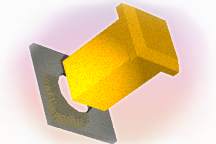beyond illustration

Hypertext creators often assume that illustrations should literally reflect the text. A typical scenario is the classic instruction manual: if we want the reader to insert Peg A into Hole B, we provide a picture of Peg A, a picture of Hole B, and perhaps a picture of the insertion in progress. This sort of illustration is indispensable when a newly opened toy has "Some Assembly Required". Its evident utility, however, has led people to believe that images should always conform to the text, that text and image must mean the same thing.
Web designers tend to use visual elements almost as literally as do the writers of assembly manuals and product catalogs: on a page about a car, they put a photograph of a car. This sort of ornamentation is usually a waste of bandwidth and of the reader's time.
This is wrong. First, it generalizes from an esoteric case (assembly instructions) to the broader realms of art, business, and science. Assembly instructions have a meaning that the reader either requires urgently or not at all; either we need to know How To Do It right away, or we could care less. Most writing, whether history, storytelling, physics, or HypertextNow, offers a wider range of messages over a broader span of time. More significantly, the assumption overlooks the complexity of semiotics -- the way people attribute meaning to symbols. Visual elements need not merely repeat what the text says; the text need not merely explain the meaning of the picture. Words and images can flow together to illuminate and subvert each other.
 At the eleventh hour of the eleventh day of November, 1918, the treaty was signed. The Great War was over. The world, once more, was at peace.
At the eleventh hour of the eleventh day of November, 1918, the treaty was signed. The Great War was over. The world, once more, was at peace.
 At the eleventh hour of the eleventh day of November, 1918, the treaty was signed. The Great War was over. The world, once more, was at peace.
At the eleventh hour of the eleventh day of November, 1918, the treaty was signed. The Great War was over. The world, once more, was at peace.
 At the eleventh hour of the eleventh day of November, 1918, the treaty was signed. The Great War was over. The world, once more, was at peace.
At the eleventh hour of the eleventh day of November, 1918, the treaty was signed. The Great War was over. The world, once more, was at peace.
 At the eleventh hour of the eleventh day of November, 1918, the treaty was signed. The Great War was over. The world, once more, was at peace.
At the eleventh hour of the eleventh day of November, 1918, the treaty was signed. The Great War was over. The world, once more, was at peace.
When we combine media, we should seek ways for each medium to convey its own message, rather than simply repeating the same message in multiple media. This is especially important in today's hypertexts, whether on the Web or in the hand, because bandwidth, storage, and screen space are precious. Tight writing demands that each medium carry the message it can best , and that their interrelation convey even more.
